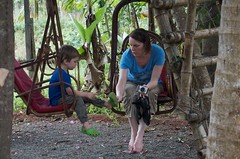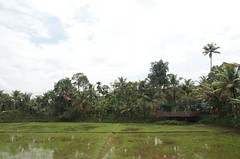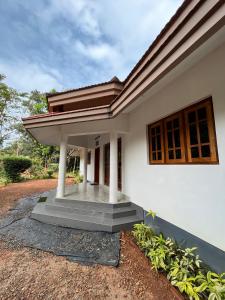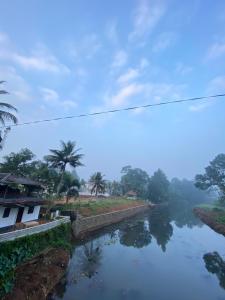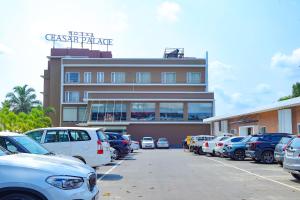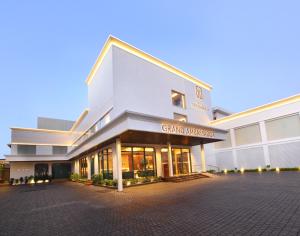Manganam
Kottayam, Malayalam: [koːʈːɐjɐm] is a city in the Indian state of Kerala. Flanked by the Western Ghats on the east and the Vembanad Lake and paddy fields of Kuttanad on the west. It is the district headquarters of Kottayam district, located in south-west Kerala. Kottayam is located in the basin of the Meenachil River at an average elevation of above sea level, and has a moderate climate. It is located approximately north of the state capital Thiruvananthapuram.
Kottayam is also referred to as "The City of Letters" as many of the first Malayalam daily newspapers, like Deepika, Malayala Manorama, and Mangalam, were started and are headquartered in Kottayam, as are a number of publishing houses.
Etymology
The royal palace of the Thekkumkur ruler was protected by a fort called Thaliyilkotta. It is believed that the name Kottayam is derived from a combination of the Malayalam words kotta which means fort (Thaliyilkotta) and akam which means inside. The combined form, Kottaykkakam (കോട്ടയ്ക്കകം), can be translated as "inside the fort".
History
Thekkumkur rule (1103 - 1753)
From the beginning of the ninth century AD, the history of Thekkumkur and of Kottayam are virtually indistinguishable. Kottayam was then a part of Vempolinad, an area in the Kulashekara Empire (800 AD – 1103 AD). By 1103, the Kingdom of Vempolinad had split into the Kingdoms of Thekkumkur and Vadakkumkur, and the latter became a vassal of Cochin.
The royal house had originally been situated in Vennimala in Kottayam. It was protected by a fort known as Thaliyilkotta and, as a result, the locality came to be known by the same name as the fort. Afterward, Thekkumkur kings shifted their capital to Nattassery near Kumaranallore at the outskirts of Kottayam town. It is believed that the Thekkumkur dynasty ruled Kottayam from Thazhathangadi. Rulers of Munjanad and Thekkumkur had their headquarters at Thazhathangadi in the present Kottayam town. Marthanda Varma of Travancore attacked Thekkumkur and destroyed the palace and the Thaliyil fort. The remnants of the palaces and forts are still seen here.
The Portuguese and the Dutch established trade relations with both of these kingdoms, dealing in black pepper and other spices. After the subjugation of the Dutch East India Company by the Kingdom of Travancore in the 1741 Travancore–Dutch War, military operations of Marthanda Varma progressed against the northern neighboring kingdoms, including Thekkumkur.
Travancore rule (1753 - 1949)
Though Thekkumkur allied with Chempakassery and Vadakkumkoor to protect the kingdom, all of them were finally annexed to Travancore. Another source states that the ruler of Thekkumkur had sided first with the Kingdom of Kayamkulam and then with the principality of Ambalapuzha against Travancore. After the fall of Ambalapuzha, and as the ruler of Thekkumkur refused to come to terms with Travancore, his capital city was taken on 11 September 1750 by Ramayyan Dalawa, the general and prime minister of Marthanda Varma, and the state was annexed to Travancore in 1753.
By the early 19th century, Travancore became a Protectorate of Britain after a series of unfair treaties. In 1817, the Church Missionary Society established CMS College as the first Western-style college in Kerala. It was welcomed by the Travancore government to provide administrators for the public bureaucracy
Kottayam has played its role in all the political agitations of modern times. The ‘Malayali Memorial ‘ agitation may be said to have had its origin in Kottayam. The Malayali Memorial sought to secure better representation for educated Travancoreans in the Travancore civil service against persons from outside. The Memorial, which was presented to the Maharaja Sri Moolam Thirunal (1891) was drafted at a public meeting held in the Kottayam Public Library. The event marked the beginning of the modern political movement in the State.
It was here that the famous Vaikom Satyagraha (1924–25), an epic struggle for eradication of untouchability, took place. Scheduled castes and other backward classes in Travancore were denied not only entry into temples, but also access to temple roads. Vaikom, the seat of a celebrated Siva Temple, was the venue of the symbolic satyagraha. Due to these protests, the Maharaja Chithira Thirunal Balarama Varma issued the Temple Entry Proclamation in 1936.
Indian Rule (1949 - Present)
Kottayam became a revenue division of Travancore. A fifth division, Devikulam, existed for a short period but was later added to Kottayam. At the time of the integration of the State of Travancore and Cochin in 1949, these revenue divisions were redesignated as districts and the Diwan Peshkars gave way to district collectors, with the Kottayam district established in July 1949.
Geography
Kottayam has an average elevation of above sea level. It is situated in the basin of the Meenachil River and in the basin of the Vembanad backwaters, which are formed from several streams in the Western Ghats of the Idukki district. The city is situated near the inland estuary of Meenachil river where it empties into the Vembanad lake in Kumarakom. According to the division of places in Kerala based on altitudes, Kottayam is classified as a midland area. The general soil type is alluvial soil. The vegetation is mainly tropical evergreen and moist deciduous.
Demographics
Population
India census, Kottayam Urban Agglomeration had a population of 172,878 while Kottayam district had a population of 1,974,551. The population of Kottayam municipality was 136,812. Males constituted 62% of the population and females 38%. Population growth in the district had a diminishing trend with a decadal population growth rate of 6.5% compared to 9.35% across the decade 1991–2000. Population growth in the municipality is due to migration for employment. Kottayam District is ranked first in literacy, with 95.9% literacy compared to 90.92% for Kerala State and 65.38% for India (2001 census).
Caste and religion
Scheduled Castes and Scheduled Tribes constituted 6.73% and 0.31% of the total population in Kottayam respectively. 19,739 persons were engaged in work or business activity, including 14,282 males and 5,457 females. In the census survey, the worker is defined as a person who does business, job, service, cultivator or labour activity. Of total 19,739 working population, 90.17% were engaged in main work while 9.83% of total workers were engaged in marginal work.
Literature
Jnananikshepam was the first newspaper published by the natives of Kerala, published at CMS press at Kottayam in 1848. Kottayam has produced many well-known writers, journalists and artists. Novelist Muttathu Varkey and poet Pala Narayanan Nair both have roots in Kottayam. Kottayam Pushpanath, a writer of crime thrillers lives in Kottayam. The Indian-English novelist Arundhati Roy is a native of Kottayam and her semi-autobiographical Booker Prize-winning novel, The God of Small Things, contains her childhood experiences in Aymanam, Kottayam. Unni R. a story writer and scriptwriter, is also from Kottayam. Kottayam was the first town in India to have achieved 100% literacy.
Media
In 1821, Benjamin Bailey, a British missionary, established C.M.S. Press, the first printing press in Kerala, in Kottayam. The town has been at the forefront of newspaper and book publishing in the state ever since.
Newspaper Malayala Manorama, published from Kottayam, is one of the largest circulating dailies in India. The Malayala Manorama Group, based in Kottayam, also owns Manorama Online, Manorama News Channel, The Week magazine and other publications. Other major Malayalam newspapers—Mathrubhoomi, Deshabhimani, Deepika, Madhyamam, and around thirty periodicals are published from Kottayam. Kottayam is also home to several Malayalam book publishers such as D. C. Books, Labour India Publications and Current Books. Almost 70 percent of books published in Kerala are from Kottayam. In 1945, a group of writers set up Sahithya Pravarthaka Sahakarana Sangham (English: Literary Workers' Co-operative Society) in Malayalam.
Governance
Legislature
Kottayam is one of the six municipalities in the district, formed after the implementation of the Kerala Municipalities Act in 1994. The members of the municipal council are elected from each of 52 wards every five years, held with the local government elections across the state. The chairperson is the executive authority of the municipality.
Kottayam town is the part of the Kottayam legislative assembly constituency and the Kottayam Lok Sabha constituency. The legislative assembly election is conducted every four years, last in May 2016.
Executive
The collectorate of the Kottayam District is located in Kottayam town. The present collector is Dr. P. K. Jayasree IAS. Many administrative and district offices of Kottayam including the District Court is situated within the collectorate premises.
Judiciary
Five courts were established during the tenure of Colonel John Munro, as the Diwan of various states in India. One of these was established in Vaikom, in the northwest of Kottaya district.
The district court at Kottayam was established in 1910 during the period of Sree Moolam Thirunal Maharaja of Tranvancore. The court celebrated its centenary in 2010.
The District Headquarters of the judiciary is set up at Kottayam town with the Principal District Court as it Administrative Centre. The justice delivery system consists of eight Munsiff Courts, ten Judicial 1st Class Magistrate Courts, three Sub Courts, one Chief Judicial Magistrate Court, and three Additional District Courts. In addition to these regular courts, two Motor Accidents Claims Tribunals, one special court for Vigilance cases and two Family Courts also function in this district.
External links
Hotels Manganam
Looking for places related to Manganam?
Those are other destinations to find places related to Manganam:

